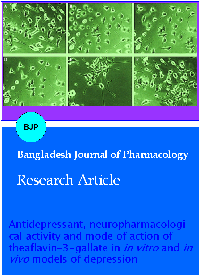Antidepressant, neuropharmacological activity and mode of action of theaflavin-3-gallate in in vitro and in vivo models of depression
DOI:
https://doi.org/10.3329/bjp.v13i4.37773Keywords:
Antidepressant, MTTAbstract
Herein the antidepressant-like effect of theaflavin-3-gallate, a plant polyphenolic compound in 1-methyl-4-phenyl pyridinium-induced neuronal injury in N2a cells used as an in vitro model of depression as well as in vivo. The results from MTT (3-(4, 5-dimethylthiazol-2-yl)-2, 5-diphenyltetrazolium bromide) and lactic dehydrogenase assay revealed that theaflavin-3-gallate exerted a neuroprotective effect in N2a cells. Treatments with mixtures of 1-methyl-4-phenyl pyridinium (20 µM) and four concentration levels of theaflavin-3-gallate increased cell viability from 23.3 to 79.6% while lactic dehydrogenase leakage value decreased from 63.2 to 23.4 U/L. Fura-2-acetoxymethyl ester assay for Ca2+ concentration measurement revealed that different doses of theaflavin-3-gallate or fluoxetine (20 µM) reduced the intracellular Ca2+ overloading in N2a cells induced by 1-methyl-4-phenyl pyridinium. Inverted phase microscopy showed that theaflavin-3-gallate induced neurite outgrowth in 1-methyl-4-phenyl pyridinium-induced neurotoxicity in N2a cells. Theaflavin-3-gallate could significantly reduce the immobility time of mice in both forced swimming test and tail suspension test.
Video Clip of Methodology:
MTT Assay: 3 min 38 sec Click to watch
Downloads
162
146 Read
47

Published
How to Cite
Issue
Section
License
Authors who publish with this journal agree to the following terms:
- Authors retain copyright and grant the journal right of first publication with the work simultaneously licensed under a Creative Commons Attribution License that allows others to share the work with an acknowledgement of the work's authorship and initial publication in this journal.
- Authors are able to enter into separate, additional contractual arrangements for the non-exclusive distribution of the journal's published version of the work (e.g., post it to an institutional repository or publish it in a book), with an acknowledgement of its initial publication in this journal.
- Authors are permitted and encouraged to post their work online (e.g., in institutional repositories or on their website) prior to and during the submission process, as it can lead to productive exchanges, as well as earlier and greater citation of published work (See The Effect of Open Access).
